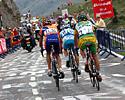
Recently on Cyclingnews.com |
View from the lab - Ric Stern's Tour de France sports science
|
|
British ABCC coach Ric Stern (www.cyclecoach.com) is a regular contributor to Cyclingnews' Form & Fitness section along with being a full time coach. Still an active rider when time allows, Ric will be providing a physiological insight into the challenges that face the riders in the Tour.
July 15, 2006: Into the mountains

|
The Tour hits the mountains, and the general classification starts to take its final shape. Some riders fall away, such as time trial winner Serguei Gonchar and others start the climb up the general classification, such as Denis Menchov.
The mountains are really the important part of the Tour de France, and provide the spectacle that many of us enjoy watching. We've all trudged up hills and mountains, and pretended they were the Col du Tourmalet or the Galibier, and imagined what it'd be like to ride the Tour and where we'd finish. Many people have ridden the Etape and gotten a feel for it. But what’s the science behind it, and how can we all improve at the vital aspect of cycling – climbing?
If we look at the top riders in the Tour we know, that on average the best riders knock out about 400 – 450 W on the final climb of the day – they sustain this for up to an hour. It’s a hugely impressive number, especially when you consider that those riders may only have a mass of around 60 – 70 kg. That’s a power to mass ratio of up to 6.5 W/kg.
If we estimate that a top rider can put out 425 W for up to 1-hour on a mountain pass, and has a mass of 68 kg, that’s a power to mass ratio of 6.25 W/kg – which will lead to a very high overall position. It’s possible that this rider could have a MAP of around 570 W. That would be ~ 75% of MAP that they can sustain for up to one hour. Most (but not all) cyclists will be able to sustain ~ 72 to 77% of MAP for such an effort irrespective of fitness. There are many regular (e.g., category 3) racing cyclists who can sustain the upper echelon of that range – it’s not just elite pros.
In the Tour the top guys – going for either a GC place or a stage win will be giving their best on the final mountain of a brutal stage, such as stage 11. Some of the others will also be riding at their maximum sustainable limits, while others will be purposefully taking it easier so that they can excel in other stages. Some riders will have no choice to ride flat out, just to make the time cuts.
Riding at ~ 425 W on a 7% grade our 68 kg rider will be travelling at about 23.8 km/h. But what would happen if he gained one kilogram (2.2 lb), how much slower would he be on a 15 km climb? Prior to the weight gain he'd fly up the climb in 37 minutes and 49 seconds. He gains a kilo and his time would slow to 38 mins and 14 seconds. That’s a time loss of 25 seconds.
What happens now, if he loses a kilogram? Well, he'll go faster… this time he reaches the summit in 37 minutes and 33 seconds, 16 seconds faster than his original time.

|
For those of you with a power meter you can see how these figures compare to your own. If you don't have a power meter (such as the SRM, or Power Tap) what do the figures mean?
Firstly, it’s important to understand that these power outputs (~ 400 W) are nothing special – this is borne out by the fact that while this stage was raging in the Pyrenees I was doing some hill intervals, and as luck would have it, I weigh about 69 kg, and was putting out up to 450 W uphill. Bear in mind I've not raced this year, but I'd be a 3rd category rider if I were racing. However, where the top guys are putting that power out for ~45-minutes and more, I could manage that power for a measly three and a quarter minutes, or put another way they can sustain that power about 14 plus times as long as I (or most 2nd and 3rd category riders) can!
So, what’s the secret of climbing well? Firstly, a high power to mass ratio is crucial, for pro cyclists in the Tour that’s going to be between 6 and 6.5 W/kg for efforts up to 1 hour. For a 3rd category cyclist that requirement maybe around 4 W/kg.
Secondly, being a lightweight rider is important, but it’s not hugely crucial. As we saw above losing a kilogram only save you a few seconds over a ~40 minute climb. Unless you are significantly overweight or completely unable to gain any more power, you're generally better off just trying to increase your power output with better training. As an artefact of better training you may find yourself losing some fat mass.
As I mentioned above, short, intense intervals around your MAP for several minutes are a great way of increasing your MAP, and will obviously help you specifically with climbs that are this duration. Of course, you also need to do less intense intervals around TTpower/effort on long climbs to build your sustainable power.
Additionally, it’s important to also learn descending skills – there’s no point getting first up the hill if you're caught and passed on the descent. However, unlike riders in the Tour de France, most of us train and race on roads that have traffic on who aren't interested in our descending skills. Accordingly, you should exercise caution on descents and follow your local traffic rules.

